Here at Pitcherlist, you may have noticed, we like pitchers with elite raw stuff. We love top-of-the-scale velocity, wicked breaking pitches, and disappearing changeups and splitters. We love swings and misses and strikeouts because those are the most effective ways to prevent runs from scoring. That doesn’t mean we don’t like pitchers who succeed through other means, but it sometimes means we fail to give them the attention and recognition they might deserve.
One of those pitchers is the Astros’ Framber Valdez, the left-hander who just gets hitters out. Since joining Houston’s rotation full-time in 2020 Valdez ranks 8th among 173 qualified pitchers in fWAR (16.2), 7th in innings pitched (781), tied for 16th in ERA (3.12), tied for 20th in FIP (3.36), and 1st in ground ball rate (62.2%, nearly 4 percentage points beyond the next closest pitcher, Logan Webb).
On a seasonal basis, he’s posted these ERAs and FIPs in the past five seasons:
Valdez is one of four pitchers — with Gerrit Cole, Max Fried, and Corbin Burnes — who have delivered ERAs under 3.60 and thrown at least 70 innings in each of the past five seasons. Am I guilty of arbitrarily picking dates and thresholds to illustrate a point? Sure. But, that kind of consistent effectiveness and durability from a starting pitcher is rare.
Whereas you might have sub-consciously envisioned Cole’s high fastball and Fried’s hammer curveball drawing a whiff, or Burnes’ spotting up his wicked cutter for a called strike on the black when seeing their names, Valdez’s superpower — generating groundball contact by the metric ton via his sinker — is different.
You might have noticed I included his groundball rate in the table above, which shows Valdez has had a year-over-year decline that took him from otherworldly to merely superhuman in that category.
That lesser groundball rate in 2023 coincided with his career’s most extended rough patch. Valdez struggled in the second half of last season (4.66 ERA) and went 0-3 and allowed 12 earned runs in 12 innings in the playoffs. Then he missed time this April with soreness in his elbow and had a pedestrian 4.34 ERA over 8 starts, in which the Astros went 3-5, at the end of May this season.
That’s far from “bad” work, but it was not what we’ve come to expect from Framber Valdez. That the Astros were well behind the Mariners in the standings at the time, staring the potential end of their dynastic run in the face, also raised the levels of concern in Houston.
Since the calendar flipped to June, however, Valdez has been back to his Ace self, throwing the second-most innings (128 ⅔) in baseball and ranking 4th in ERA (2.38) and 6th in FIP (2.94).
Let’s walk through how he’s gotten back on track.
More Velocity Isn’t Always Better
One of the first things that stands out when digging into Valdez is how his velocity has increased since he first broke through to the majors. As a swing starter and long reliever in his first two seasons, he averaged around 92 mph with his sinker. In the starting rotation, that crept up to almost 94 mph by 2022 and topped 95 mph last season:
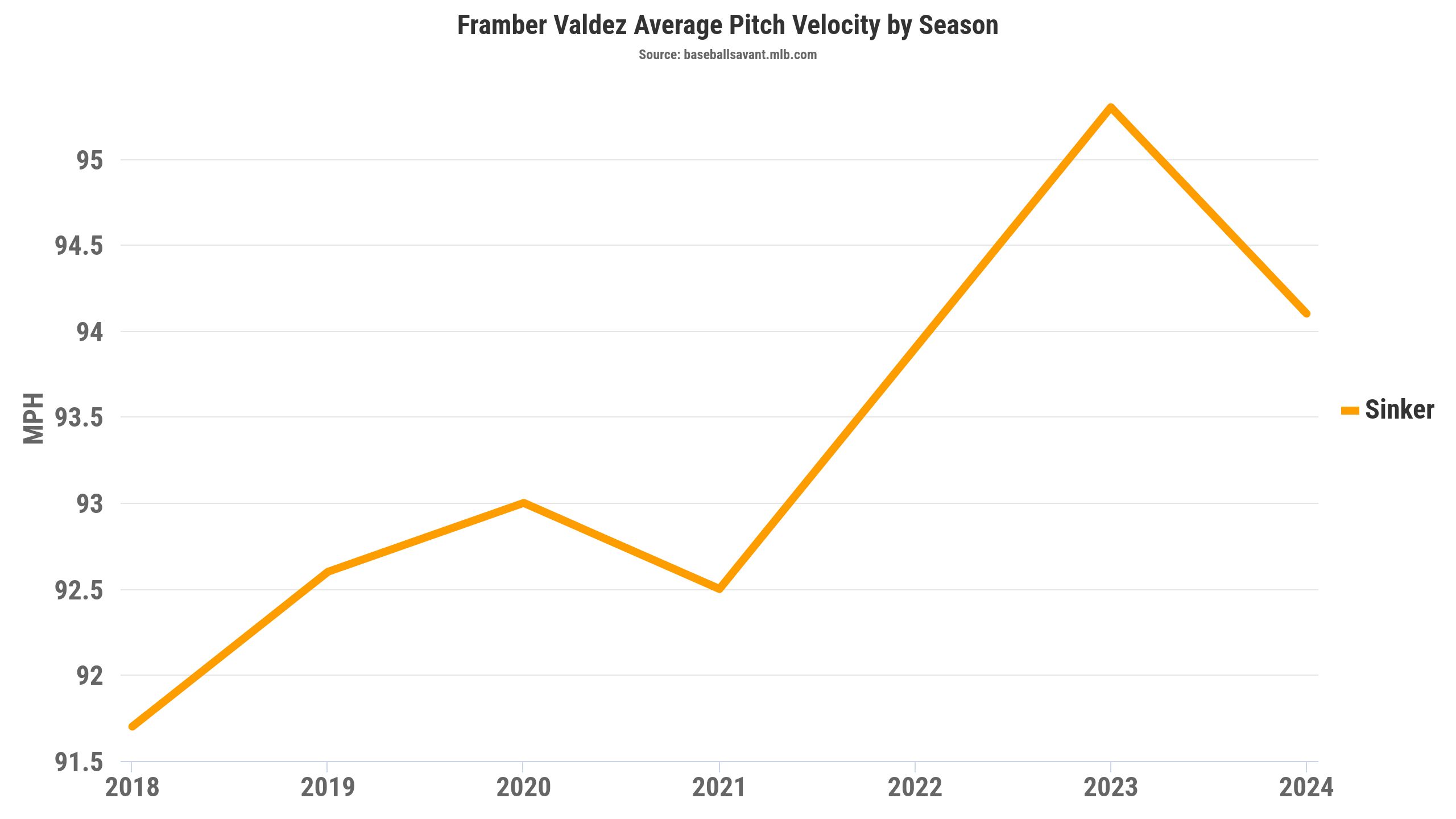
In a vacuum, more velocity is usually a good thing. Greater velocity tends to miss more bats and suppress slugging more than lower velocity, and Valdez adding heat to his signature offering fit right in line with a league-wide trend to throw faster sinkers. Gone are the days of touch-and-feel sinker ballers trying to paint the bottom of the zone with 91. Instead, this is preferred:
Framber Valdez, Wicked 97mph Two Seamer. 🤢 pic.twitter.com/YJ3XXapAuh
— Rob Friedman (@PitchingNinja) September 6, 2023
At issue for Valdez though, is that as his velocity increased, his sinker became easier for batters to elevate and hit for power, which I’ve highlighted in the table below. And, his increased sinker velocity did not come with enough of an increase in missed bats and strikeouts (despite the GIF above) to compensate for that increased extra-base contact.
Last season, Valdez allowed 38 extra-base hits on his sinker alone, including 11 home runs, despite averaging a career-best velocity with the pitch. The season before that he’d allowed 23 and 8 of those, respectively. The season before he’d only allowed 11 and 6, when he mostly worked between 92 and 93 mph with it.
The thing about general tendencies drawn from group statistics is that they don’t always apply at the individual level. More velocity, in theory, should have helped his sinker. But it clearly had the opposite effect.
Different Movement, Spin Direction, and Location
One of the main reasons for those counterintuitive results, as Cody Poage detailed for The Crawfish Boxes, is that the increased sinker velocity corresponded with a changed movement profile. Namely, it had significantly less downward movement at the higher velocity.
Said another way, the induced vertical break (IVB) of Valdez’s sinker — that is, the upward vertical movement going against gravity — increased and made his sinker sink less:
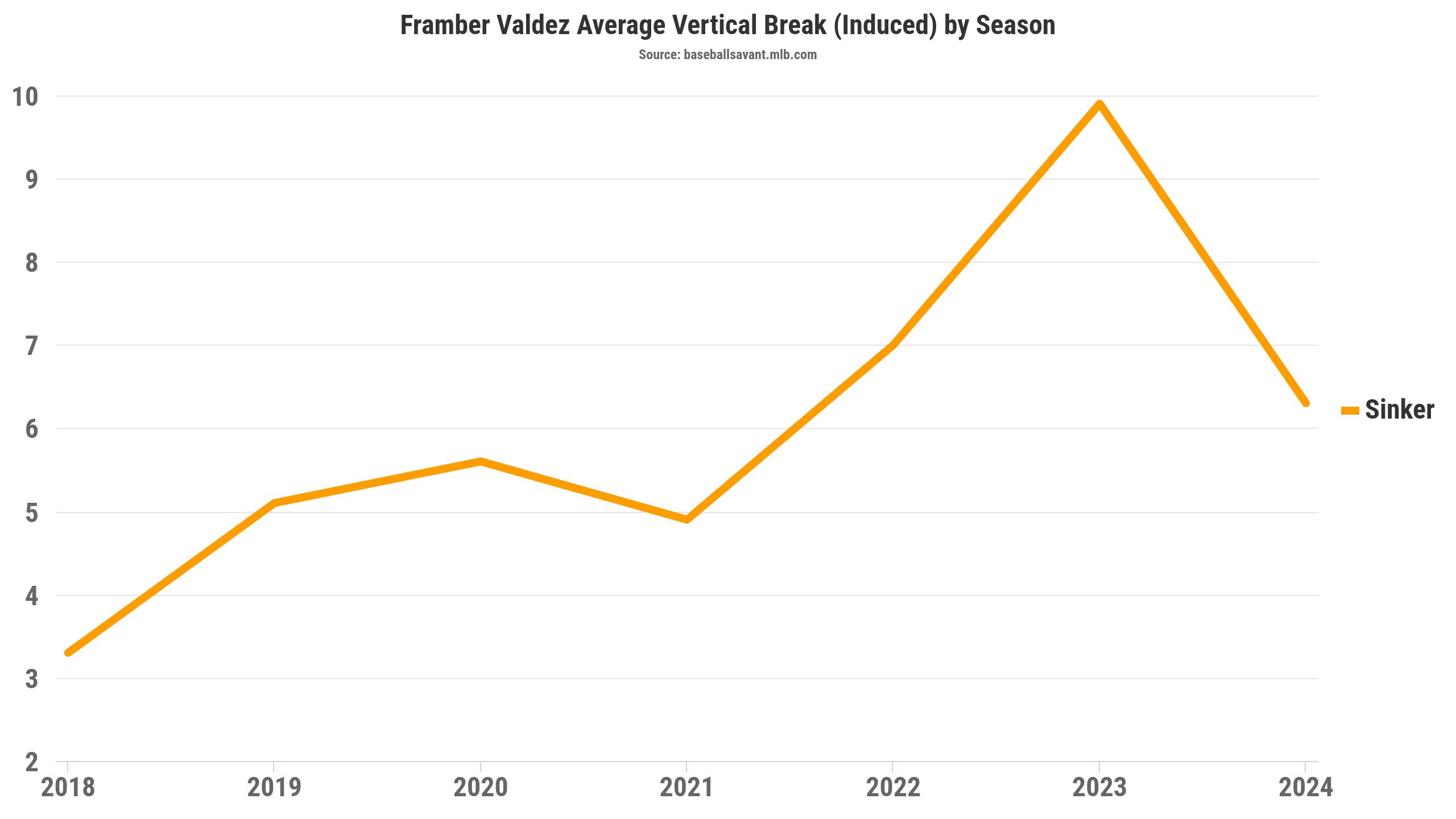
More velocity meant a little less time for gravity to do its thing and push the pitch down.
But, it wasn’t all about the velocity increase.
Valdez also gradually changed how he was releasing the pitch such that he was throwing it from a higher arm angle, which we can see very clearly from the new arm angle data and graphics from Baseball Savant:

Courtesy of Baseball Savant
There’s a clear multi-year trend that correlates well with the velocity and vertical movement data I showed above, with a larger relative change in 2023. That higher angle contributed to him “getting behind” his sinker more, which imparted more backspin (which leads to IVB) at the expense of some preferred sidespin into it, which Mario Delgado Genzor explained for Baseball Prospectus.
You can see the effects of this evolution over time in the table here:
As Valdez’s release point went higher, his spin direction moved closer to 12:00 (which is pure backspin), which meant his percentage of spin contributing to movement (active spin) increased, driving more IVB and less sink.
If you’d rather see this as a visual, here’s a comparison of his pitch movement in 2022 and 2023. If you focus on the orange plots in the upper left of the chart you can see the 2023 data is clustered higher in the chart, reflecting less movement:
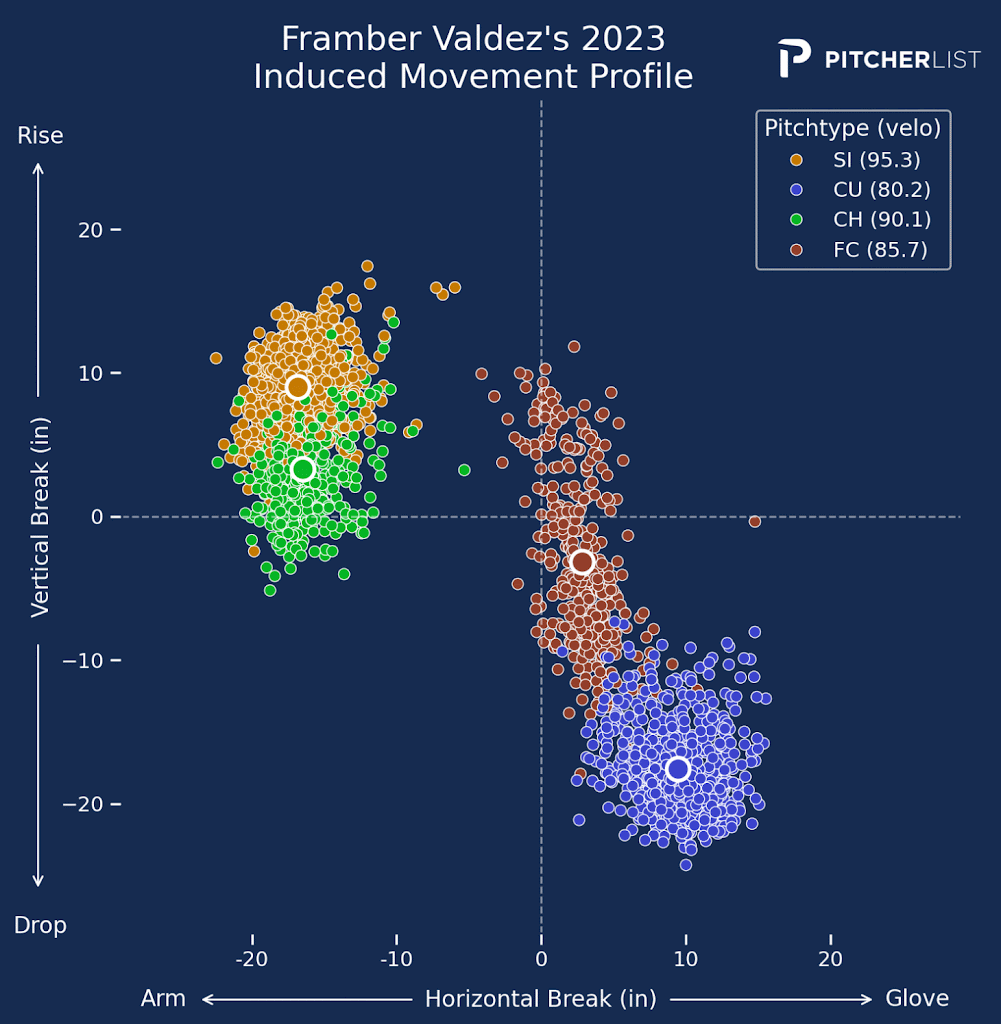
With less downward break, Valdez struggled to get his sinker to the bottom of the zone, especially against right-handed hitters, and more of them landed higher in the zone where they were easier to hit hard and in the air. Check out how the red area on the right-hand chart slides up and to the right over time:
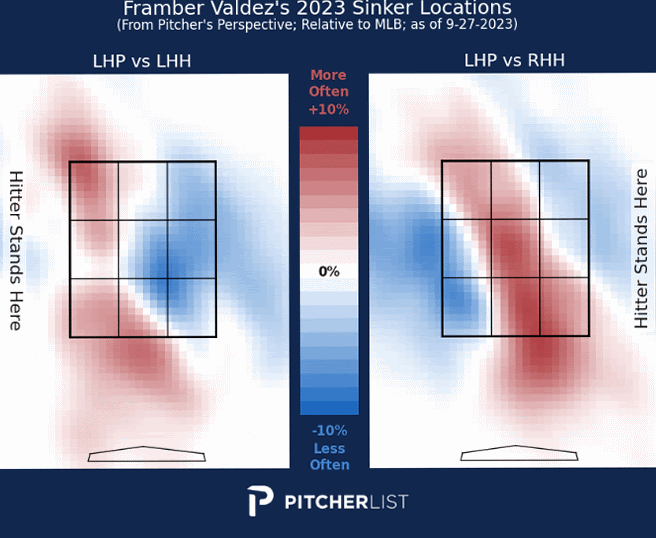
Lower is Better
If you’ve been paying close attention throughout this article, you’ll have noticed that I also included Valdez’s 2024 metrics in the tables and charts. They reveal that Valdez has re-embraced a “lower is better” approach this season, which has brought him back to his worm-burning, slug-suppressing ways.
His sinker velocity is reduced from last season at 94.1 mph. He’s lowered his arm angle back down to 43°, which has helped re-orient the spin direction on his sinker to 10:45 and taken off some active spin, which has reduced the IVB on the pitch back down to 6.3 inches. That’s put the sink back into his sinker (24.8 inches with gravity) and helped him more consistently locate it at the bottom of the zone, especially to right-handed batters:
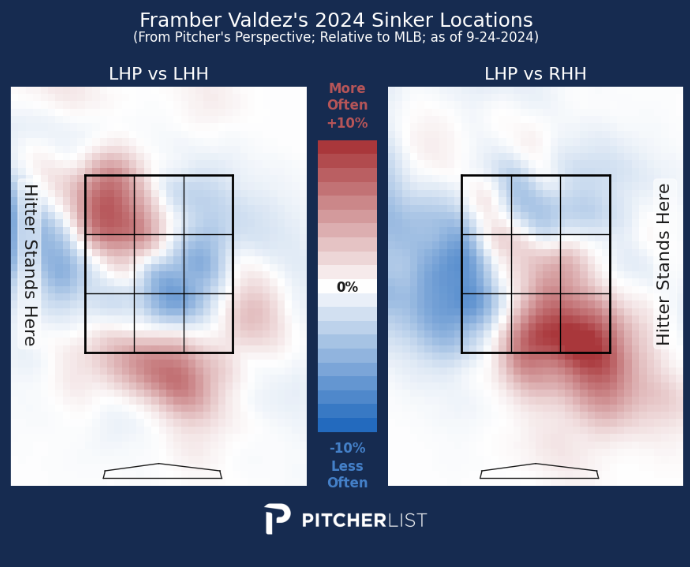
As a result, the average batted ball in play against Valdez has been 0.4° off the bat, and he’s once again leading MLB in ground ball rate (60.6%). That’s eliminated 18 extra-base hits and 6 homers compared to last season, which has allowed Valdez to be one of the most effective starting pitchers in the game. More importantly, as the calendar switches to October, the Astros are 16-4 in games started by the renewed Valdez since the start of June, helping the club erase that deficit in the standings and win the AL West for the fourth straight season.
Houston will be matched up with the upstart Detroit Tigers in the American League Wild Card series later today and they’ll send Valdez to the mound in Game 1. That’s a promising matchup for the Astros, not only because of how well Valdez has been throwing, but also because the Tigers’ hitters ranked last in the league in production against sinkers (.298 wOBA) this season. It will be fun to watch how well Valdez manages the emotions of a home playoff start and to see if he can keep a little heat off his sinker when the adrenaline is pumping. If Houston is to make another deep post-season run, Valdez continuing to execute his “lower is better” adjustments will be an important reason why.
Photo by Leslie Plaza Johnson/Icon Sportswire | Feature Image by Justin Redler (@reldernitsuj on Twitter)



